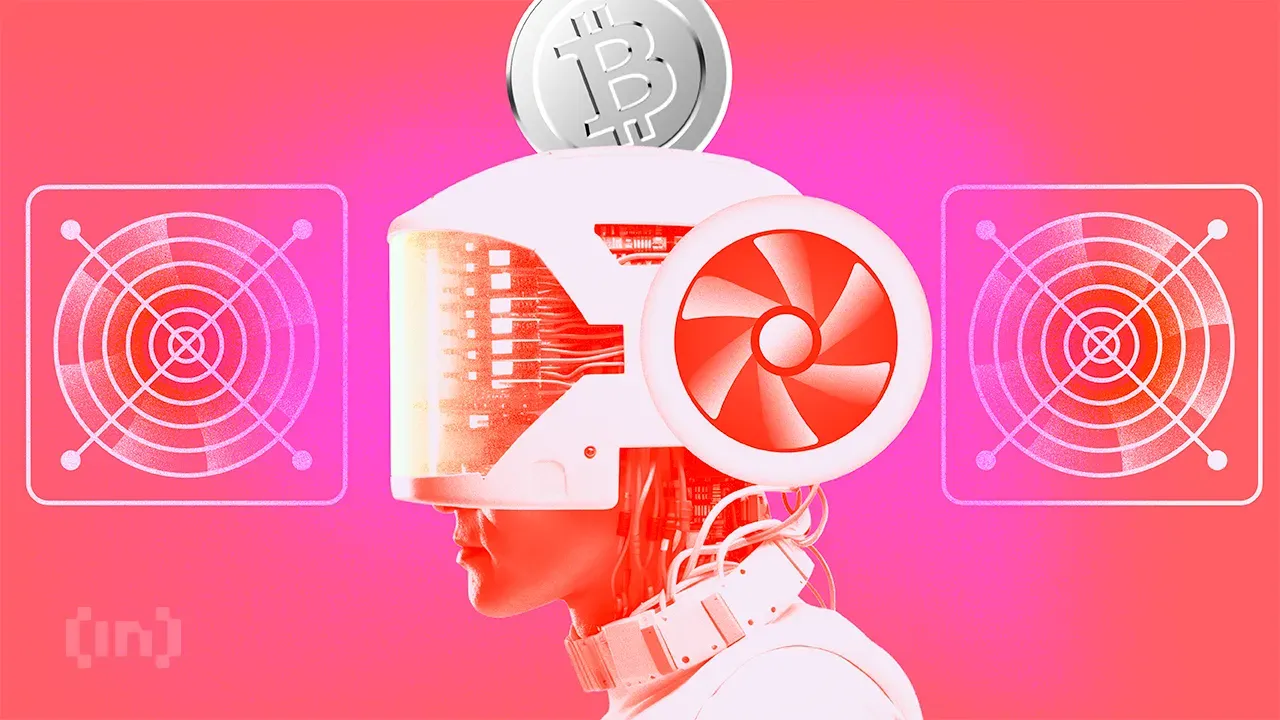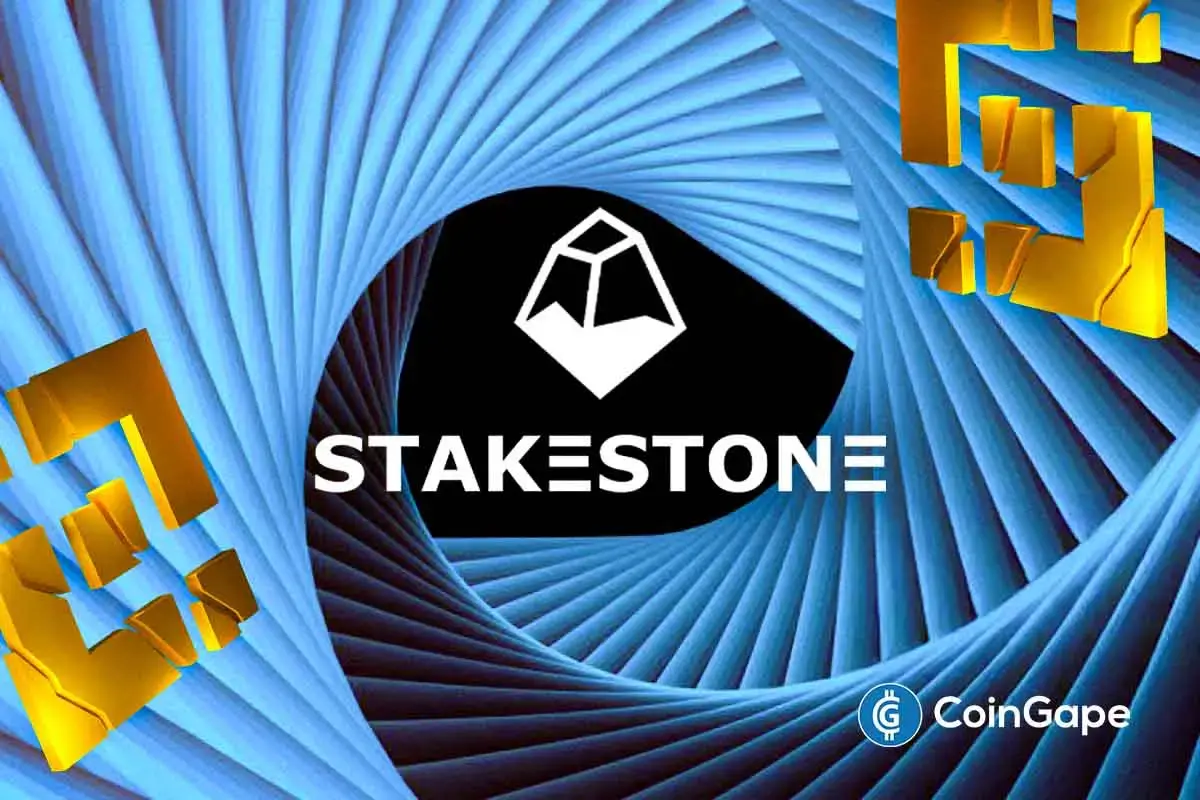Market
Yat Siu Talks Blockchain Gaming and Digital Identity

Yat Siu, co-founder and executive chairman of Animoca Brands shared his unique perspective on the evolving landscape of Web3, drawing from his extensive experience in tech innovation and his multicultural background.
In a recent interview with BeInCrypto, Siu highlighted the stark contrast between Eastern and Western attitudes. He also offered valuable advice for aspiring artists in the age of AI.
As a global leader in blockchain and gaming, Siu’s vision for the future of blockchain technology was evident in his discussion of Mocaverse, a project aimed at solving digital identity issues in Web3. His insights on China’s approach to blockchain and Hong Kong’s role as a crypto sandbox provided a nuanced view of the industry’s global dynamics.
Q: Why do you think the MOCA price rose significantly, compared to other Game tokens?
There is a whole series of tokens that haven’t done that well. But some have done well like Bitcoin, Ethereum, Solana, and TON, plus in our case, I would argue MOCA, too. The key difference is the institutional support. Projects with institutional backing tend to perform more stably. Starting with the Bitcoin ETFs, I think we’re entering an institutional era of crypto, meaning that, to stand out, you now need institutional support.
Q. How does the institutional support help the growth of projects?
The traditional stock market is by-majority institutional, but the token market is by-majority retail. In an institutional market, you diligently research to know what the project is about because you have large purchasing power and long-term planning.
Retails have a lot more short-term behavior naturally. For instance, Pump.fun launched two million tokens in the last 6 months. It is amazing as a business model, but also concerning. Among the new tokens, many of them are very small, and may also be very speculative.
An institution will not invest in Pump.fun. They have discipline. In this age, projects that have institutional support and capability become much more relevant.

Q: As an advisor to the Hong Kong Government’s Web3 Task Force, how do you interpret the recent atmosphere of the industry in China and Hong Kong?
Although President Xi Jinping put blockchain technology into his agenda, you can’t just assume by China saying “we’re supportive of blockchain”, that they will allow Bitcoin to be traded in China. You can’t even trade the US dollar in China, and what makes you think it should be okay to do crypto?
But there is a role for Hong Kong, which has been a financial clearing house for international capital in and out of the mainland.
It makes sense that Hong Kong is becoming pro-Web3 and pro-Crypto because it is the sandbox for China. If something happens, it can happen in Hong Kong and won’t affect China. Moreover, Chinese capital might flow out to other places, but it would rather be in Hong Kong, a free market under China’s influence than move to the US ally’s soil like Singapore.
Read more: Crypto Regulation: What Are the Benefits and Drawbacks?
Q. You have a Chinese background, but you grew up in the West, in Austria. How do Web3 and GameFi differ between East and West?
Asia is more pro-capitalist and the West is split between capitalism and, especially in Europe, more socialism. In Asia, even in China, they are capitalists by nature, and it doesn’t matter if you are called the Communist Party. That is not true for Europe and many young Americans. So if you’re a gamer in Asia, you make money with your assets and it’s okay because by nature you are comfortable with capitalism. But in Europe, people don’t necessarily agree with that. In America, the younger generation doesn’t necessarily believe in capitalism because it hasn’t worked for them.
There’s an ironically greater love of capitalism in Asia, which is why DeFi and GameFi are growing. I wouldn’t say everyone, but there’s a much louder voice of people in the West who don’t like it. If you talk to gamers in the West, they will say “I don’t want money to swallow my game”.
Q. Between Game Boy (of Nintendo) and Game Science (of Black Myth: Wukong), which one would you choose?
I would go for the Game Boy. I’m very proud that Black Myth: Wukong can be a global hit coming out of China. It’s an interesting moment. However, Wukong would not have been possible to be popular if it wasn’t for the earlier kinds of Asian game companies and Asia-led culture booms leading the way. In other words, the Chinese moment came thanks to Japan and Korea. Japanese anime paved the way for K-pop and K-drama, and K-culture did the same for China. Even if Wukong might become bigger, Gameboy should be respected.
Q: You studied music in college in Vienna. As an artist, what advice do you have for aspiring artists in the age of AI?
Regardless of what you do, especially for those who want to do creative things, it is important to own your property. The most successful musicians like Michael Jackson had a growing asset base because they owned their intellectual properties. On top of that, you need to understand money and business which we don’t teach in school. You can’t have independence if you outsource the value of the system. If you have an idea, if you create music, if you’re a performer, the important thing is to make sure you own enough of your property to have the long tail benefit for your work. Maybe it would make no difference if you’re not very successful, but if you have something successful, you know what I mean.
Q. How can blockchain benefit content creators?
The biggest theft in Web2 was those like YouTube, Instagram, and Tiktok. In the early days of YouTube, mukbangs, live-streamed videos where viewers watch the host eat, were very popular, but even when the creators became famous, the content was not theirs and they lost the IPs to YouTube. The same is true for Instagram, and when people take a photo on Instagram, they spend a long time getting the angle. But they don’t get paid for the work or its IP. Even when you make a video that goes viral on TikTok, you get nothing. In Web3 with blockchain, you own the property. If you mint it as an NFT, you have the history and the record. You will be able to defend theft from the blockchain. You can’t stop it, but you can trace and claim its ownership. That’s the point.
Q: What major factors of the industry have drawn your attention recently?
The crypto industry has grown over the last 12 months. We’ve had a lot more launches, a lot more projects, and a lot more people involved in the space.
In particular, we’re excited about TON and Mocaverse. The TON ecosystem brings many users into Web3 and our games like Gamee now have 90 million users. And for the Mocaverse, we think it’ll solve digital identity. Often it is the same people who are essentially farming the tokens which is a problem. You want to make it more distributed and you want to make it not go to bots but to individuals. You need an identity solution, and that’s what Mocaverse is doing.
Disclaimer
In compliance with the Trust Project guidelines, this opinion article presents the author’s perspective and may not necessarily reflect the views of BeInCrypto. BeInCrypto remains committed to transparent reporting and upholding the highest standards of journalism. Readers are advised to verify information independently and consult with a professional before making decisions based on this content. Please note that our Terms and Conditions, Privacy Policy, and Disclaimers have been updated.
Market
PiFest Celebrates Success – But Pi Coin Value Keeps Falling

Pi Network recently celebrated a milestone with its first PiFest in the Open Network, showcasing impressive participation numbers.
However, despite the event’s success, the value of Pi Coin (PI) continues to plummet, sparking concerns among its community of Pioneers.
PiFest Fails to Bolster Pi Coin’s Value
Pi Network’s team announced the results of its first PiFest, a community-driven event designed to integrate PI into local commerce. According to the post, over 125,000 registered and 58,000 active sellers participated in the event. In addition, 1.8 million Pioneers utilized the Map of Pi app for transactions.
The event facilitated a wide range of purchases, from groceries and clothing to professional services like design and automotive repairs, showcasing PI’s growing utility in the real world.
“PiFest is more than a celebration—it exemplifies and demonstrates Pi’s real-world utility. With Open Network fully live, PiFest shows how Pi can support genuine commerce and empower local economies worldwide,” the blog read.
Despite these achievements, the event failed to bolster PI’s market performance. According to data from CoinGecko, PI has fallen to the 31st position in the rankings. Currently, Pi Coin is trading 78.7% below its peak value. Meanwhile, it’s just 3.1% above its lowest recorded price.
As of press time, Pi Coin’s trading price was $0.6, a decline of 8.2% over the past day. Additionally, over the past 30 days, the token has experienced a significant drop of 64.5%.

This sharp downturn has fueled negative sentiment within the community.
“The comments are getting more and more negative from this accounts tweets. Finally looks like “some people” are waking up to this being a failure in terms of what promises were sold of what this would be, and obviously is not,” a user posted on X.
Meanwhile, users are increasingly considering converting their PI holdings to other assets amid the altcoin’s ongoing struggles to maintain its value. In fact, a Pioneer openly debated trading their PI for 1 Ethereum (ETH).
“Shortly after Pi launched, my holdings were worth around €7,000. I decided to hold onto them, expecting a potential Binance listing or a major announcement from the team—something that never happened. Now, my Pi is worth around €1,700, and I feel extremely disappointed,” a user wrote on Reddit.
The post sparked a heated discussion, with some users encouraging the trade, citing Ethereum’s more established market position. Despite this, many still continue to advocate for PI, believing in its long-term potential.
“Be patient. Trust the process. Believe in the Pi core team, developers, ecosystem and the community. Do not spread FUD. Hold your Pi. Never sell cheap. You will be rewarded big time in the future,” a Pioneer posted.
As the community grapples with the token’s underperformance, opinions remain divided. The outcome of this ongoing debate will likely depend on future developments and the Pi Network’s ability to regain investor confidence.
Disclaimer
In adherence to the Trust Project guidelines, BeInCrypto is committed to unbiased, transparent reporting. This news article aims to provide accurate, timely information. However, readers are advised to verify facts independently and consult with a professional before making any decisions based on this content. Please note that our Terms and Conditions, Privacy Policy, and Disclaimers have been updated.
Market
Stablecoin Regulation Bill Passes US House as Market Heats Up
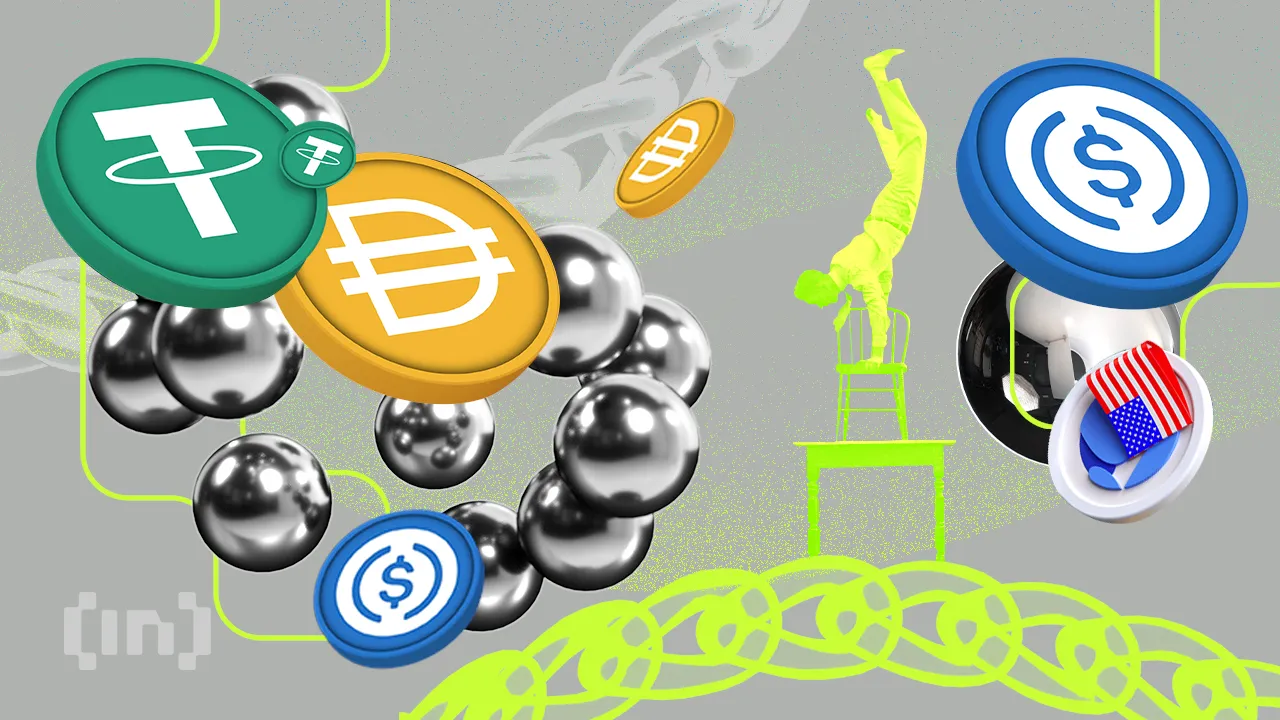
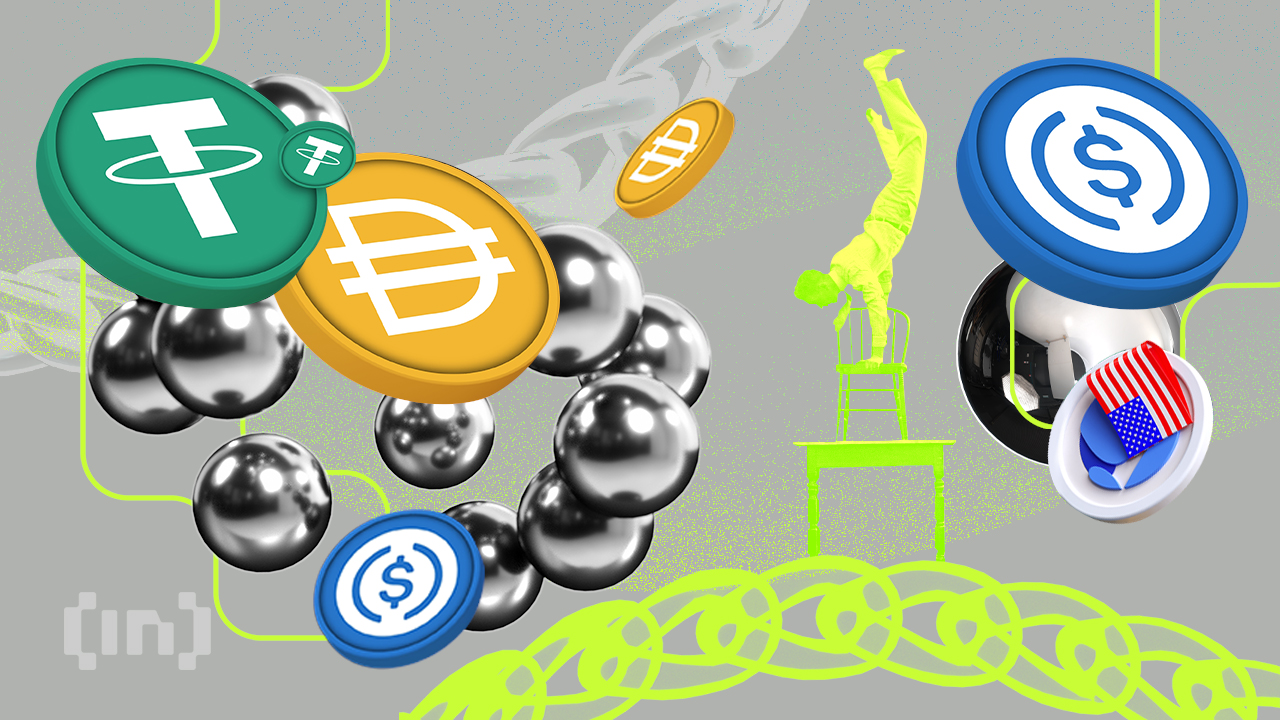
The US House Financial Services Committee voted 32-17 to pass the Stablecoin Transparency and Accountability for a Better Ledger Economy (STABLE) Act of 2025, aimed at stablecoin regulation.
This legislative milestone comes amid growing activity in the stablecoin market. Competition is heating up as major traditional financial institutions prepare to enter the space.
STABLE Act Passes Committee Vote
Chairman French Hill and Representative Bryan Steil spearheaded the legislation (H.R. 2392). It seeks to establish a robust framework for stablecoin issuance, mandating 1:1 reserve backing, monthly audits, and AML requirements.
“This legislation is a foundational step toward securing the future of financial payments in the United States and solidifying the dollar’s continued dominance as a world reserve currency,” Representative Steil remarked.
The bill’s passage saw bipartisan support, with six Democrats voting in favor. Notably, this comes shortly after the US Senate Committee on Banking, Housing, and Urban Affairs greenlit the GENIUS Act. The bill passed in a bipartisan 18-6 vote.
“The bills await debate time on the floor and a vote in their respective chambers,” Journalist and Host of Crypto In America, Eleanor Terrett, noted.
According to Terrett, efforts are underway to align the two bills closely over the next few weeks. The aim is to address differences between the bills. Aligning them will make it easier to proceed without creating additional complications.
“If they can get them to be in relatively the same place on their own, it will avoid having to set up a so-called conference committee which is formed so members from both chambers can negotiate to create a final version of the bill everyone agrees on,” she added.
Stablecoin Competition Heats Up, but Are There Signs of a Purge?
The drive for legislation occurs alongside rising activity in the stablecoin market. Global players are joining the fray.
For instance, in Japan, Sumitomo Mitsui Banking Corporation (SMBC) and major entities have signed a Memorandum of Understanding (MoU). The MoU initiates joint discussions on the potential use of stablecoins for future commercialization.
“This Agreement will see SMBC, Fireblocks, Ava Labs, and TIS collaborate to develop a framework for stablecoin issuance and circulation, including exploring key technical, regulatory, and market infrastructure requirements both in Japan and further afield. This Joint Discussion will not only focus on pilot projects but will aim to concretely define use cases for ongoing business applications,” the notice read.
In addition, Bank of America’s CEO previously revealed plans to launch a stablecoin once proper regulation is in place. Notably, BeInCrypto reported last month that the Office of the Comptroller of the Currency (OCC) had granted national banks and federal savings associations permission to provide crypto custody and certain stablecoin services.
That’s not all. The state of Wyoming is set to launch its own stablecoin, WYST, in July. Fidelity has also announced similar plans. Moreover, President Trump-backed World Liberty Financial officially launched its USD1 stablecoin in late March. This highlights continued interest in stablecoin adoption across both private and public sectors.
Meanwhile, Ripple announced the integration of its Ripple USD (RLUSD) into Ripple Payments. Changpeng Zhao (CZ), former CEO of Binance, reacted to the development on X.
“Stablecoin war, I mean healthy competition, just getting started,” CZ said.
As competition intensifies, the stablecoin market is also facing growing pains. Despite new entrants gaining traction, some players face heightened scrutiny.
Justin Sun, founder of Tron (TRX), recently accused First Digital Trust of insolvency. Following Sun’s allegations, First Digital USD (FDUSD) temporarily depegged.
The market’s future may hinge on the survival of only the most compliant and resilient stablecoins. This leads to a potential “purge” where weaker players fail to meet the increasing regulatory and market demands.
Disclaimer
In adherence to the Trust Project guidelines, BeInCrypto is committed to unbiased, transparent reporting. This news article aims to provide accurate, timely information. However, readers are advised to verify facts independently and consult with a professional before making any decisions based on this content. Please note that our Terms and Conditions, Privacy Policy, and Disclaimers have been updated.
Market
Ethereum Price Recovery Stalls—Bears Keep Price Below $2K

Reason to trust

Strict editorial policy that focuses on accuracy, relevance, and impartiality
Created by industry experts and meticulously reviewed
The highest standards in reporting and publishing
Strict editorial policy that focuses on accuracy, relevance, and impartiality
Morbi pretium leo et nisl aliquam mollis. Quisque arcu lorem, ultricies quis pellentesque nec, ullamcorper eu odio.
Ethereum price attempted a recovery wave above the $1,880 level but failed. ETH is now trimming all gains and remains below the $1,880 resistance zone.
- Ethereum failed to stay above the $1,850 and $1,880 levels.
- The price is trading below $1,850 and the 100-hourly Simple Moving Average.
- There was a break below a key bullish trend line with support at $1,865 on the hourly chart of ETH/USD (data feed via Kraken).
- The pair must clear the $1,865 and $1,890 resistance levels to start a decent increase.
Ethereum Price Fails Again
Ethereum price managed to stay above the $1,800 support zone and started a recovery wave, like Bitcoin. ETH was able to climb above the $1,850 and $1,880 resistance levels.
The bulls even pushed the price above the $1,920 resistance zone. However, the bears are active near the $1,950 zone. A high was formed at $1,955 and the price trimmed most gains. There was a break below a key bullish trend line with support at $1,865 on the hourly chart of ETH/USD.
A low was formed at $1,781 and the price is now consolidating near the 23.6% Fib retracement level of the downward move from the $1,955 swing high to the $1,781 low.
Ethereum price is now trading below $1,850 and the 100-hourly Simple Moving Average. On the upside, the price seems to be facing hurdles near the $1,850 level. The next key resistance is near the $1,865 level and the 50% Fib retracement level of the downward move from the $1,955 swing high to the $1,781 low.
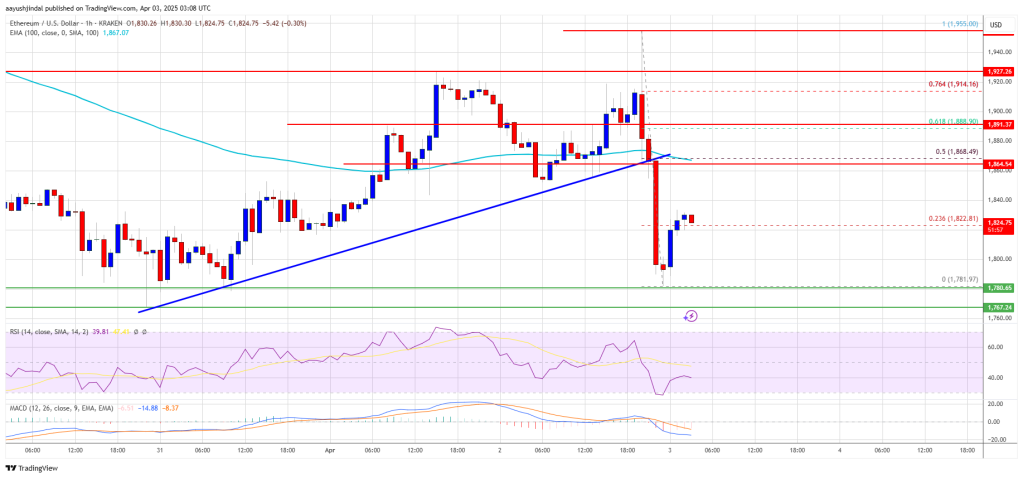
The first major resistance is near the $1,920 level. A clear move above the $1,920 resistance might send the price toward the $1,950 resistance. An upside break above the $1,950 resistance might call for more gains in the coming sessions. In the stated case, Ether could rise toward the $2,000 resistance zone or even $2,050 in the near term.
Another Decline In ETH?
If Ethereum fails to clear the $1,865 resistance, it could start another decline. Initial support on the downside is near the $1,800 level. The first major support sits near the $1,780 zone.
A clear move below the $1,780 support might push the price toward the $1,720 support. Any more losses might send the price toward the $1,680 support level in the near term. The next key support sits at $1,620.
Technical Indicators
Hourly MACD – The MACD for ETH/USD is gaining momentum in the bearish zone.
Hourly RSI – The RSI for ETH/USD is now below the 50 zone.
Major Support Level – $1,780
Major Resistance Level – $1,865
-

 Regulation19 hours ago
Regulation19 hours agoKraken Obtains Restricted Dealer Registration in Canada
-

 Altcoin15 hours ago
Altcoin15 hours agoHere’s Why This Analyst Believes XRP Price Could Surge 44x
-

 Altcoin21 hours ago
Altcoin21 hours agoFranklin Templeton Eyes Crypto ETP Launch In Europe After BlackRock & 21Shares
-

 Bitcoin21 hours ago
Bitcoin21 hours agoLummis Confirms Treasury Probes Direct Buys
-
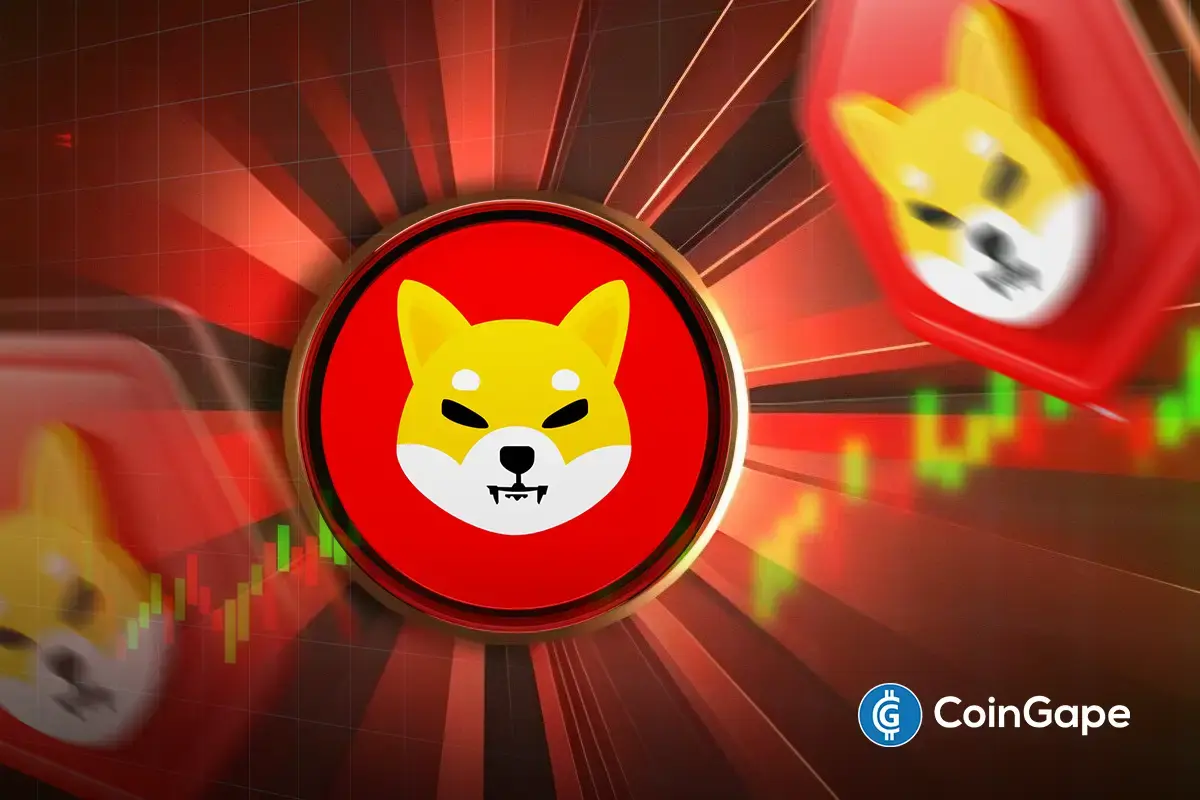
 Altcoin23 hours ago
Altcoin23 hours agoWhat’s Fueling The Shibarium Boost?
-

 Altcoin14 hours ago
Altcoin14 hours agoHow Will Elon Musk Leaving DOGE Impact Dogecoin Price?
-

 Altcoin11 hours ago
Altcoin11 hours agoFirst Digital Trust Denies Justin Sun’s Allegations, Claims Full Solvency
-

 Ethereum13 hours ago
Ethereum13 hours agoWhy A Massive Drop To $1,400 Could Rock The Underperformer


